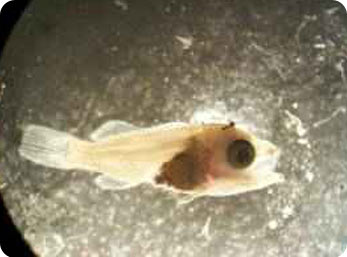Marine scientists have been probing conditions in the cold current off the coast of Southern California for more than six decades now. During frequent research cruises, they measure the current’s temperature, speed, salinity, and other conditions. They also sample the organisms in the water. And in recent years, they’ve counted a lot more baby fish in the water at much earlier dates -- a change likely caused by changes in ocean temperature.
 Rockfish larva, some species of rockfish are spawning earlier than in the past. Credit: National Oceanic and Atmospheric Administration
Rockfish larva, some species of rockfish are spawning earlier than in the past. Credit: National Oceanic and Atmospheric AdministrationThe California Current flows from Canada to Baja Mexico. It pulls up cold, nutrient-rich water from the deep ocean, which supports abundant life near the surface.
Recent research shows that there’s a lot more young life in the waters of Southern California at earlier times of the year than ever before. The counts of fish larvae show that 18 of the 43 most abundant species of fish are spawning anywhere from two weeks to two months earlier than when the research cruises began in the early 1950s. The list includes species of mackerel, rockfishes, and others. At the same time, another eight species are spawning up to five weeks later.
Researchers who conducted the study say the most likely cause is warmer water -- an increase of about two degrees Fahrenheit over the last six decades. As the water continues to heat up, it could change the growth rates of some species of fish. It could also force some species to move farther north, where the water is colder -- just one more change to the life on Earth caused by our planet’s warming climate.

